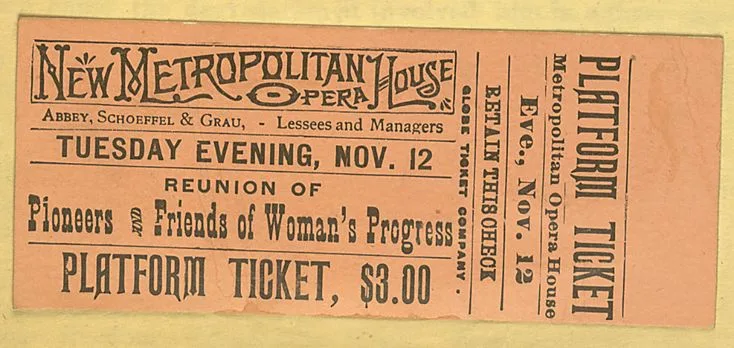The Digital Revolution in Ticketing for Live Events: From the Past to the Future
The evolution of live event ticketing from paper tickets to e-ticketing through digitization has simplified ticket purchase and management, improving the audience experience. From ancient Rome to the present, the industry has innovated to the use of blockchain and collaboration with the SIAE to ensure security, convenience and respect for copyrights.
23 April 2024
Ticketing has always played a crucial role in the organization and management of live events. From small local gatherings to large concerts and sporting events, ticketing has been the primary means by which the public accesses events and organizers track attendance.
In recent decades, with the advent of digital technology, the ticketing industry has undergone a momentous transformation from traditional paper-based ticketing practices to advanced e-ticketing and digital ticketing systems. This change simplified the process of purchasing and managing tickets. It has also opened up new opportunities to improve the overall event experience for spectators.
The Origin of Event Ticketing: A Brief History
The origin of event ticketing dates back to a time when the need to manage the influx of people to events of various kinds was being felt. Although there is no exact date for the introduction of ticketing, it is assumed that it originated as a response to the growing demand to attend cultural, religious and sporting events where the number of spectators exceeded the capacity of available spaces.
The use of ticketing systems may also have more cynical roots related to social and economic segregation. In many ancient societies, access to exclusive events was reserved for the wealthier classes, while ordinary people had limited or no accessibility. Consequently, the introduction of ticketing may also have been a way to separate social classes and maintain a certain status quo within society.
An ancient history of ticketing: from Roman badges to the modern paper system
The earliest evidence of a ticketing system dates back to ancient Rome, where cards or tesserae were used to guarantee access to performances in amphitheaters and arenas. These tiles could be made of pottery, colored stones or other materials and were used as passes to enter events. At the Colosseum in Rome, for example, each arch and staircase was numbered, and tickets indicated the number of the arch and staircase closest to the assigned seat, thus facilitating the flow of spectators inside the monument.
The capacity of the Colosseum, which could accommodate between 45,000 and 87,000 spectators, required an efficient ticketing system to ensure quick and orderly access during events. In addition, the Colosseum was equipped with advanced security measures, such as archers placed on catwalks and nets over some sections to protect spectators from animals or accidents.
Although there are no written accounts of riots at the Colosseum, it is possible that Roman authorities had taken preventive measures to ensure the safety of spectators and maintain order during events. This demonstrates the importance of a safe and well-organized environment for successful ticket sales and the overall spectator experience.
Over time, especially in the 18th century, early forms of paper ticketing were introduced. Theaters and shows began issuing prepaid paper tickets as a means of access to events, marking the beginning of an era of more organized and controlled ticketing.
From the Ancient to the Modern Age: The Evolution of Methods of Access
From Roman clay discs to brass tokens in 18th-century theaters, methods of accessing events have continued to evolve over the centuries. The introduction of paper tickets made event management more efficient and provided a more secure system for securing spectator admission.
In 1732, the Theatre Royal, Covent Garden had a very simple system. They charged spectators to enter and had no physical ticketing system. The fact that it was a London theater made it easier, as it was common for theaters at the time to report that there was no guarantee of seating at the entrance.
By 1755, it was common practice for theater managers to issue prepaid brass or bronze tokens as “tickets.” Although this helped managers control the number of spectators in attendance and keep track of event revenues, they were generally only good for one show. The first recorded use of paper tickets for admission to an event dates back to 1786, when the first proper ticketing agency was established in London to sell tickets for performances at the Royal Opera House.
Toward the Modernization of Ticketing Systems: From 1868 to the Twentieth Century
During the 19th century, new ticketing systems were introduced, including subscriber tickets and early models of numbered tickets. These innovations have enabled event organizers to better manage attendance and offer special benefits to loyal customers.
Subscriber tickets, available in 1868, were a reusable token, usually made of bone, that represented access to a favorite seat in the theater on a series of days or on particular days of the week. In the late 1800s paper cards became commonplace, and in the early 1900s they began to evolve with more ornate borders and fancy colored inks. However, the use of paper tickets has also made it easier for unscrupulous individuals to engage in ticket scalping. This led to increasingly complex security methods, such as even more decorated borders and even fancier inks. Unfortunately, flashy inks and ornamental borders were not enough, and so in the 1940s serial numbers began to appear on the cards.

Sports games were a source of inspiration for the creation of uniquely shaped tickets, such as baseballs and catcher’s mitts for baseball tickets, thus testing the artistic and craftsmanship skills of counterfeiters. Then in the 1950s, special paper, watermarks and microprinting began to be used.
The practice of microprinting relies on the presence of extremely small text on the card and very difficult to replicate. To understand what this is all about, it was not unusual to see a 0.5-point font, still visible to the naked eye but obviously more difficult to copy. For comparison, some passports use a 0.1-point microprinted character to deter counterfeiting. For reference, a 1-point font is about 0.35 mm tall, so a 0.1-point font would be a tenth of that.
The Innovation of Paper Ticketing: From Early Ticket Agencies to Subscriber Tickets
In the 1960s, event tickets began to be sold through authorized outlets, such as box offices and ticket agencies, rather than being sold directly by event organizers.
The introduction of the first ticketing agencies and subscriber tickets further revolutionized the way spectators accessed events. Ticketing agencies have made tickets more accessible to spectators, allowing them to conveniently purchase tickets from authorized outlets. This helped to reduce the risk of counterfeits entering circulation by distributing the responsibility of ticket authentication to authorized dealers. In the 1970s, tickets were equipped with holograms and the tickets themselves began to be collectible.
Subscriber tickets, on the other hand, offered customers the opportunity to secure access to a range of events or performances in exchange for an upfront payment. This model has enabled event organizers to establish a loyal customer base and ensure a steady stream of revenue.
From Paper to the Digital Age: The Transformation of Event Ticketing
With the advent of the Internet and online ticket sales, the event ticketing industry has undergone an unprecedented revolution. LLhe proliferation of specialized websites and platforms has made it easier for consumers to purchase tickets from the comfort of home. It has also made its order management more efficient.
In addition, the introduction of mobile ticketing methods has further simplified the process of purchasing and admission to events. With the use of smartphones and dedicated apps, spectators can now purchase, transfer and use tickets quickly and conveniently. This eliminates the need for paper or printed tickets.

The Technology of the Future: Blockchain and Advanced Security
In addition to innovative platforms, the use of contactless and biometric ticketing methods, such as the use of RFID technology and facial recognition, has increased for security and convenience. These methods allow for a smoother and more efficient event admission process.
Looking to the future, there is potential for the use of blockchain technology in event ticketing (it has already been done virtually). The use of blockchain, a decentralized digital ledger, could potentially eliminate fraud and scalpers by creating a secure and transparent record of ticket ownership.
Integration with the Italian Society of Authors and Publishers (SIAE)
The integration of ticketing with the Italian Society of Authors and Publishers (SIAE) is a significant step in ensuring respect for copyrights and proper management of royalties in the live events and entertainment sectors. It has been a process that has developed in line with the advancement of technology and the needs of the live event industry.
Collaboration between ticketing systems and the SIAE enables more accurate monitoring of ticket sales. This also allows you to keep track of the number of spectators attending events. This helps to ensure that artists and authors receive fair compensation for the use of their works during performances.
Through efficient integration, ticket sales and event performance data can be transmitted directly to the SIAE, enabling faster processing of royalties and greater transparency in the payment process.
In addition, integrating ticketing with the SIAE can facilitate the management of licenses and permits required for the use of copyrighted works at events, minimizing the risk of litigation and penalties for copyright infringement.
Showtime! Apps: Innovation and Personalization in Ticketing
In the context of the digital ticketing revolution for live events, our solution, Showtime! Apps, represents a benchmark for organizers seeking to optimize the user experience. Our strategy is clear: to offer applications that not only facilitate the ticket-buying process but also make this experience more personalized.
With apps made through Showtime! Apps, users can purchase tickets very easily and carry them with them on their mobile devices at all times, completely eliminating the need for paper tickets. This not only increases convenience for the user, but also reduces the risk of ticket loss or theft, providing greater security.
Recognizing the importance of adapting to the diverse needs of event organizers, we do not simply offer a standard product. Our platform allows for complete customization, integrating with different existing ticketing systems. This approach allows organizers to choose the online ticketing system that best suits the specifics of their offerings and organizational needs, thus ensuring a tailored solution that improves the effectiveness and efficiency of the service offered.
Ultimately, Showtime! Apps not only follows current trends in digital ticketing, but anticipates them, offering innovative solutions that meet the needs of an increasingly demanding and connected audience. With our apps, event access for audiences becomes easier, safer and more enjoyable, elevating the entire end-user experience and positioning us as a true game changer in the live event industry.
